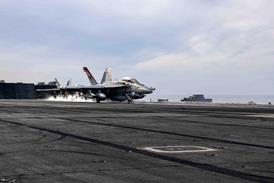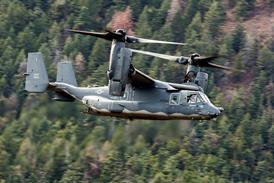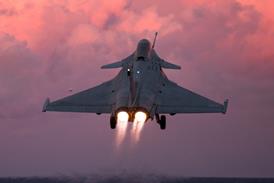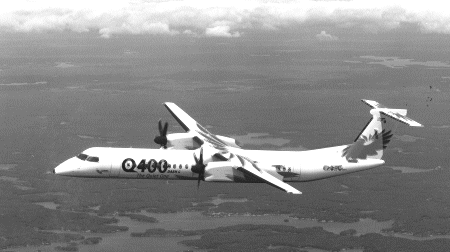
Graham Warwick/WASHINGTON DC Cutaway Poster/Tim Hall
Gentlemen prefer blondes and passengers prefer jets - two claims as hard to disprove as they are to prove. But Bombardier believes it can prove the latter claim to be inaccurate with its new 70/78-seat regional turboprop, the Q400, formerly the de Havilland Dash 8-400.
Conceived as an extension to a successful bloodline, the Q400 has come to embody the hopes for the survival of the breed. Bombardier believes the technology incorporated in the Q400 can reverse the regional turboprop's declining passenger popularity, while offering operating economics that no regional airline can afford to ignore.
Convinced that its noise and vibration reduction technology can change passenger perceptions of turboprops, the Canadian company has renamed the Dash 8 family "The Q Series" - Q for quiet - consisting of the 37-seat Q200, 50-seat Q300 and new Q400.
Behind the renaming is the recent introduction of the NVS active noise and vibration control system, installed on new production Dash 8s since earlier this year and now available for retrofit. Bombardier believes that the resulting improvement in cabin environment - and further noise reduction measures incorporated in the Q400 - will go a long way to eliminating any passenger aversion to turboprops.
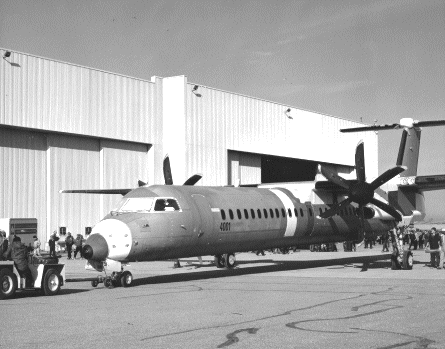
CUTTING A DASH
Toronto, Canada-based de Havilland launched the original, 37/39-seat, Dash 8 Series 100 regional turboprop in 1980, following it in 1986 with the stretched, 50/56-seat, Series 300. The Series 200, a hot-and-high version of the -100 offering increased commonality with the -300, was introduced in 1992. Some 500 Dash 8s have been delivered.
The Dash 8-400 was conceived to meet the twin requirements for a bigger and faster aircraft - bigger to accommodate projected growth in regional airline traffic, and faster to provide block times competitive with short-haul jets. Designers at de Havilland quickly zeroed in on a 70-seat aircraft with a 350kt (650km/h) cruise speed.
The Dash 8-400 was on the drawing board before Bombardier acquired de Havilland from Boeing in 1992, but the programme was not launched until 1995. Launch of the Canadair Regional Jet Series 700 (CRJ-700) followed shortly after, and gave the company a foot in both 70-seat camps.
The relatively slow sales of both aircraft have led critics to question Bombardier's strategy, but the company remains confident that the 70-seat market will unfold in line with its forecasts - and with the distinction between short range (turboprop) and long range (jet) operations that is the company's justification for developing apparently competing 70-seaters.
Based on its experience so far with the 50-seat CRJ, relatively few of which have replaced turboprops, Bombardier believes that turboprops will remain the most economic solution for short haul and low yield operations. To bolster its argument that the two markets are distinct, Bombardier points out that the average sector distance flown by Dash 8s is 344km (186nm), compared with 760km for the CRJ.
The company says that 85% of turboprops now operating are used on stage lengths of less than 550km. The Q400 is aimed at the heart of this market and, Bombardier claims, offers 30-40% higher productivity than competing large turboprops, through a combination of more seats and higher speed.
As well as offering turboprop operators a growth path, Bombardier believes the 70-seater is "...a cost-effective replacement for older, depreciated jets on short sectors", citing SAS Commuter's plans to use Q400s to replace 80-seat Fokker F28 jets as well as 50-seat Fokker 50 turboprops. Crucial to tapping into the short-haul jet replacement market will be the Q400's operating economics. The manufacturer calculates that the break-even load factor will be just 29.5% on a 360km sector, allowing the aircraft to compete profitably with 100/150-seat aircraft in short-range markets.
One key to achieving the forecast operating economies is the commonality that will exist across the 36/78-seat Dash 8/Q Series. A common crew qualification will allow operators to maintain a pilot pool and match aircraft seating capacity to market demand, Bombardier says. The company calculates that commonality in training, maintenance and spares add up to a $1 million per aircraft "present-value benefit" over a fleet of six Q300s and six Q400s.
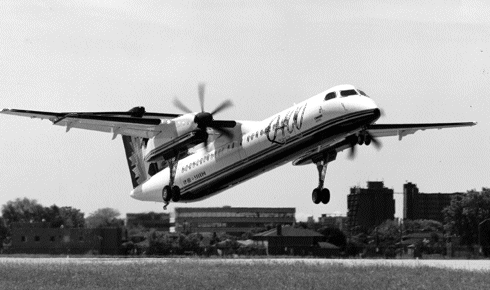
VIRTUALLY ALL NEW
The Q400 is virtually an all-new aircraft, so extensive are the changes from previous versions of the Dash 8. Airframe, engines, avionics and systems are all affected to a greater or lesser degree by the twin requirements to make the aircraft bigger and faster.
While the nose section is unchanged and the tail section is strengthened, the entire centre fuselage section is new, and is extended 6.8m. The tapered outer wing panels are strengthened, but the constant-chord inner wing section is new and there is a new wing/body joint. The vertical tail is strengthened, but there is a new, increased-area horizontal tail.
The engines, propellers and nacelles, the flightdeck and avionics, and the landing gear, wheels, tyres and brakes are all new designs and/or new suppliers. Most of the systems are revised to a greater or lesser extent.
The changes to the fuselage go beyond simply stretching it to accommodate up to 78 passengers. The cross-section and structural concept is carried over from previous Dash 8s, but the number and location of doors and exits are new to the Q400.
There are now two passenger entry doors on the left side, at the forward and aft ends of the cabin where, on the right side, there are now emergency exits. The underwing exits of the previous Dash 8s could not meet evacuation requirements because of the longer fuselage, Goobie says, so the exits were moved to the extreme ends of the cabin. The aft exit is also a galley service door.
A new baggage door has been added on the right side of the forward fuselage. This provides external access to a new baggage compartment aft of the cockpit. A door provides access to this compartment from the cabin, but only for storage and retrieval of service trolleys, Goobie says. The main baggage compartment is in the aft cabin, behind a bulkhead and with external access door via a door on the left side.
Bombardier offers several cabin configurations, ranging from an interior providing high amenity levels for European service (70 seats at 780mm pitch, two lavatories and large galley) to a high-density layout for low-yield markets (78 seats at 760mm pitch, one lavatory and smaller galley and baggage areas). The new forward compartment allows the company to offer a 70-seat configuration with large baggage capacity, aimed at US hub markets.
MORE CAPACITY
The new inner wing, which runs from nacelle to nacelle, increases span and fuel capacity. The wing sits on top of the fuselage and the junction is enclosed in a new fairing shaped in part by the aircraft's higher speed. On previous Dash 8s, standard fuel is contained in the outer wing panels, the integral tanks stopping at the outer edge of the engine nacelles. On the Q400, the wing tanks continue inward to end just outboard of the fuselage, says Goobie.
The nacelles themselves are new. Changes include composite cowl doors, which are lighter than the previous titanium panels. The engine mount is also changed, with a hydraulic torque compensation system replacing the mechanical torque tube. This is lighter and improves the aerodynamic lines of the nacelle, Goobie says. It also allows for better tuning of the mounting system, he says, providing stiffness to react the propeller torque while dampening the up-down motion of the engine.
Changes to the tail include relocation of the option auxiliary power unit (APU) to the tailcone, where it is enclosed in titanium doors. The biggest change is the larger horizontal stabiliser, needed to balance the longer fuselage. There is also a new bullet fairing at the tip of the fin, required to reduce drag at the Q400's higher cruise speed.
The elevators are now hydraulically powered, and a third hydraulic system has been added. This is a backup system with an electrically driven pump. The two main hydraulic systems are engine-driven. As with previous Dash 8s, the ailerons are manually controlled while the roll spoilers/lift dumpers and two-segment rudder are hydraulically actuated.
Other systems changes are driven by the Q400's increased size and weight - and in the case of the landing gear, Goobie says, by the decision to change vendor. Menasco Aerospace supplies the Q400 landing gear and, while the main gear is beefed up to cope with the aircraft's higher weight, the nose gear design is similar to that on previous Dash 8s. There are new wheels, tyres and brakes and new steer-by-wire and brake-by-wire control systems.
ASSOCIATED CHANGES
Most major systems changes are associated with the new engines and avionics. Previous Dash 8s are powered by Pratt & Whitney Canada PW100-series turboprops, and the Q400's PW150A ostensibly is a member of the same family of powerplants, "...but it is a new engine, not a derivative," says Goobie. Power is increased by more than 70% over that of the PW123 used in the -200/300, and PW150 is over 50% more powerful than any previous member of the PW100 family.
Maintaining commonality with existing Dash 8s was of paramount importance to the Q400's designers, and the PW150 does retain the mechanical layout of the PW120 series, as well as existing locations for accessories, servicing and inspection. Although "only the oil cap is common", says Goobie, the new engine's design provides for commonality in maintenance procedures and training.
The PW150 has a two-spool gas generator and a two-stage free turbine driving the propeller. Airflow through the compressor, which has three axial stages and one centrifugal, is increased by 75% over that of the PW123. While the engine has a thermodynamic capability of 4,800-5,600kW (6,500-7,500shp), in the Q400 it is "conservatively" rated at 3,780kW (compared with 2,200kW for the PW123). This allows normal take-off power (3,410kW) to be maintained to 37.4íC at sea level. The engine is expected to produce around 2,600kW at altitude, Bombardier says.
The PW150 is the first Dash 8 powerplant to be digitally controlled. The dual-channel full authority digital engine control (FADEC) is produced by P&WC sister company Hamilton Standard. In addition to improving engine performance and handling, the FADEC offers several operational benefits.
One of these, Goobie explains, is the ability to dispatch the aircraft with failures in the control and monitoring systems. Based on the reliability histories of components, the system will inform the ground crew of the time remaining before known faults must be rectified. Goobie says this time-limited despatch capability is based on a "sophisticated model" of the engine which is run within the FADEC.
ELECTRONIC CONTROL
The Dowty R408 propeller also is electronically controlled. Compared those on previous Dash 8s, the new propeller has increased diameter 4.1m (13.5ft) and six blades, for a lower blade loading at higher power. The all-composite blades have two carbonfibre spars, polyurethane foam core, glassfibre/carbonfibre shell forming the aerofoil, and a nickel leading-edge erosion sheath. One recent design change, Goobie says, has been to adopt a lighter, composite, propeller spinner in place of the original aluminium unit.
Selection, location and operation of the propellers are elements of a concerted attack on noise and vibration, perceived by passengers as characteristics of turboprops. Clearance between the propeller and the fuselage is increased by 44% over that on previous Dash 8s, and propeller speed is reduced. At 1,020RPM for take-off, reducing to just 850RPM in the cruise, propeller speed on the Q400 is 6-19% slower than on other Dash 8s.
Electronic propeller control allows for accurate synchrophasing, and there is a propeller balance monitoring system that measures vibration in flight and indicates to the ground crew where to place the balancing weights. Goobie says Bombardier looked at an automatic balancing system, but decided it was "too risky".
Having taken measures to minimise their creation, Bombardier has then tackled the transmission of noise and vibration into the cabin using both passive and active suppression techniques. The company has great hopes for its NVS active noise and vibration reduction system, developed jointly with supplier Ultra Electronics, and fitted to all new Dash 8s, including the Q400.
Active noise control is not new in regional turboprops, but Bombardier flight-tested the conventional loudspeaker-based noise cancellation approach and found it to be "unacceptable". One reason was that anti-noise can create cabin "hot spots", where sound levels are actually increased; another was that speaker-based systems do not tackle the propeller-induced fuselage vibration that causes cabin noise.
The solution was to develop a system that, rather than countering cabin noise, works to minimise the transmission of vibration into the cabin. The NVS uses active tuned vibration absorbers (ATVAs) mounted on fuselage frames and controlled by an onboard processor, which receives signals from a propeller tachometer and microphones in the cabin wall.
QUIETER CABINS
Flight testing of the NVS in a Dash 8-100 showed a maximum 10dBA reduction in noise level, at the second seat row (in the plane of the propellers). New production Dash 8s fitted with the NVS are achieving a 75dBA average cabin noise level "with a high degree of consistency", Bombardier says, adding that a -300 with NVS "-is effectively as quiet in the cruise as a CRJ." The design target for the Q400 is an average cabin noise level of 77dBA.
Where possible, in revamping the Dash 8 design, Bombardier has moved to the latest generation of technology. Nowhere is this more evident than on the Q400's flightdeck, where the usual array of conventional instruments has been replaced by a row of five large liquid crystal displays (LCDs).
To allow for a common type rating between existing Dash 8s and the new Q400, the locations and presentations of the conventional instruments are mimicked on the screens of the 150 x 200mm LCDs - round dials remain round and remain in the same positions relative to each other. Elsewhere, panel layouts and switch labels remain similar, where feasible.
Each pilot has a primary flight display (PFD) with a multifunction display (MFD) alongside. In the centre of the panel is the engine and system display unit. This is not a full-blown EICAS [engine indication and crew alerting system], Goobie admits, as there is also a separate caution/warning panel, both to reduce cost and to maintain commonality with previous Dash 8s.
The display suite provides some of the same capabilities as an EICAS, such as the ability to call up system schematics. This has allowed Bombardier to simplify the overhead panel, by moving some system indications to pages on the MFDs. The display suite also has the capability for advanced formats, and Q400 customer SAS Commuter has specified a PFD with vertical-tape airspeed and altitude presentations.
The entire integrated avionics system, including the displays, is supplied by Sextant Avionique and is based on a series of modules plugged into a single cabinet. These include modules for the display processors, automatic flight-control system, air-data computers, and attitude/heading reference system.
There is also a central diagnostic system, which collects maintenance information from the avionics modules and other aircraft systems. "This is not as sophisticated as the systems in big jets, but is fairly capable," Goobie says. In addition there is a separate engine monitoring unit, supplied by P&WC.
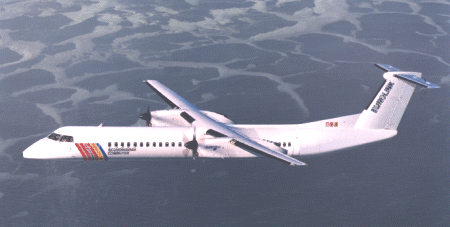
JOINT DEFINITION
Bombardier formally launched the Dash 8-400 programme in June 1995. Applying lessons learned from previous risk-sharing programmes, the company brought engineers from all the partners together at de Havilland in Toronto for a joint definition phase (JDP). This resulted in definition of the interfaces between the airframe sections and aircraft systems to be supplied by the participants.
When the JDP was completed in July 1996, the partners went home to design, produce and test their parts of the aircraft knowing that all of the interfaces had been frozen. Partners were then responsible for the detailed design of their structure or system, and well as the construction of any test rig required (see box).
Four aircraft have so far joined the flight test programme. The first three are fully instrumented prototypes: 4001 is assigned to performance testing; 4002 to systems development; and 4003 to avionics testing. The fourth aircraft is partially instrumented prototype and is the first to be fully furnished; 4004, with a 78-seat interior, will be used for NVS and evacuation testing. A fifth Q400, production standard aircraft 4005, will be rolled out in September, and will be used for function and reliability testing leading up to certification.
Bombardier says the flight-test programme is on schedule for certification in March next year. Testing required for Canadian, European and US certification is being conducted simultaneously. Goobie says there have been no "unpleasant surprises" so far in the test programme, which he attributes to "...extensive windtunnel and system rig testing and computer modelling of aircraft behaviour."
One external change made so far is the addition of strakes, 3.7m long by 350mm wide, on either side of the lower rear fuselage, to improve directional stability. "Windtunnel testing showed a probable need for the strakes on the rear fuselage and that has been confirmed by flight testing," Goobie says. The strakes are metal, but various options are being looked at to reduce the current 36.4kg weight penalty, he says. Further weight savings are expected from the switch to lighter flat-braided wiring for various aircraft systems.
With about one-third of the test programme completed by the beginning of August, highlights include demonstration of the Q400's 350kt cruise speed. First runs have been completed on the optional Sundstrand APU, which is not required for inflight restart of the engines and so is ground operable only.
Production standard PW150As have been fitted to aircraft 4002, allowing installed power and airfield performance tests to proceed. The avionics software has been upgraded to the penultimate Version 300, and the autopilot has been activated.
Icing trials lie ahead, and Bombardier is considering conducting cold-soak tests in an indoor facility at Eglin AFB in Florida, with inflight natural icing tests to be performed in Ontario. Bombardier does not anticipate problems, and is expecting an on-time start to deliveries in June next year.
The Q400 orderbook is still relatively slim, with 34 aircraft on firm order. SAS Commuter is the largest customer to date, with 17 aircraft on order, followed by Taiwan's Uni Airways with six, Tyrolean Airways with five and Germany's Rheintalflug and Norway's Wideröe with one each. Four unannounced orders make up the balance.
Bombardier seems unconcerned by the slow start, and is holding firm to its estimate of an eventual market for 400 Q400s. This is based on forecast sales of some 1,500 aircraft in the 60- to 90-seat short range (under 360km) market over 20 years (to 2016). Whether this forecast is realised will depend largely on the success of the Q Series, and particularly the Q400, in changing passenger perceptions of turboprops.
CHANGES FROM THE DASH 8-300
Design goals for the Q400 were to incorporate new technology which increased productivity and profitability, while maintaining a high degree of commonality with existing Dash 8s.
Changes from the 50-seat Dash 8-300 proved to be more substantial than just stretching and re-engineing the aircraft, not least because Bombardier chose to develop the Q400 with new risk-sharing partners (see box).
The airframe is designed for the same 40,000h/80,000-flight crack-free life and 80,000h/160,000-flight economic life as existing Dash 8s, which Bombardier says outlast other regional airliners.
Q400: PARTNERS AND VENDORS
Risk-sharing partnerships on the Q400 programme are not "build-to-print" agreements. Instead, the partners are required to supply a fully tested structure or system, and are responsible for its performance "as installed".
Many of the partners have built test rigs to support their involvement in the programme. These include rigs for the flight controls (at Parker), flap drive system (Microtechnica), electrics (AlliedSignal) and fuel system (Parker). Sextant built two integrated avionics test rigs, one of which is now located at Bombardier's Wichita, Kansas, flight test centre to support certification testing of the Q400.
Source: Flight International




